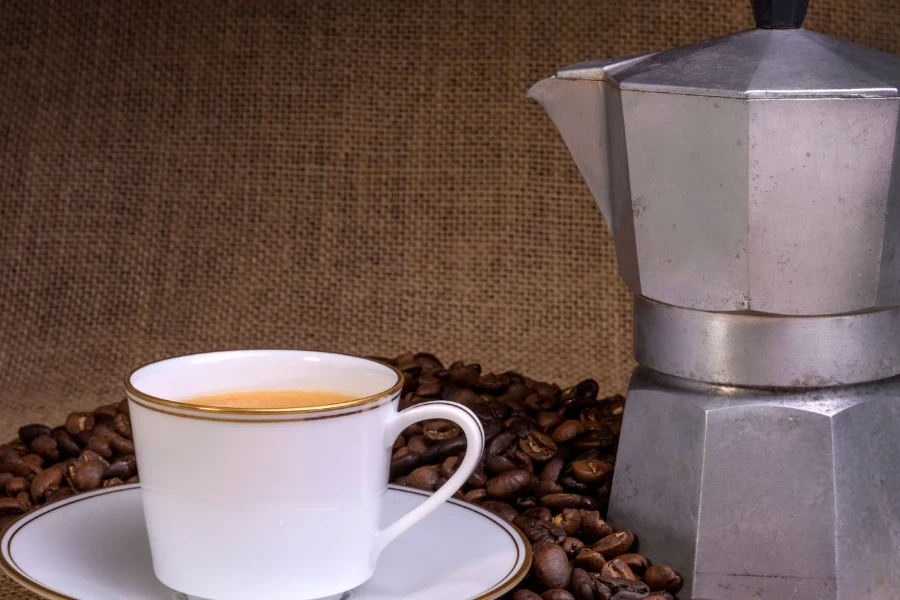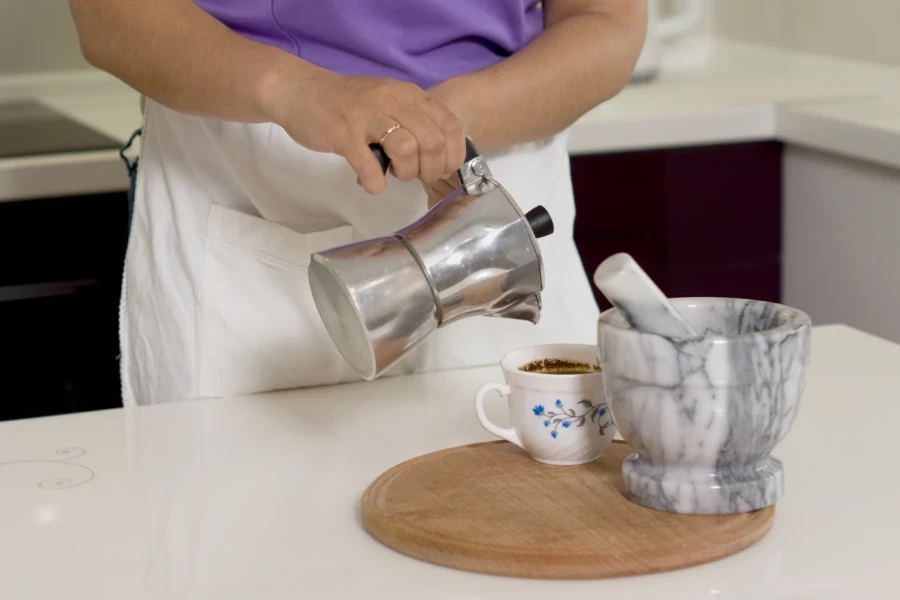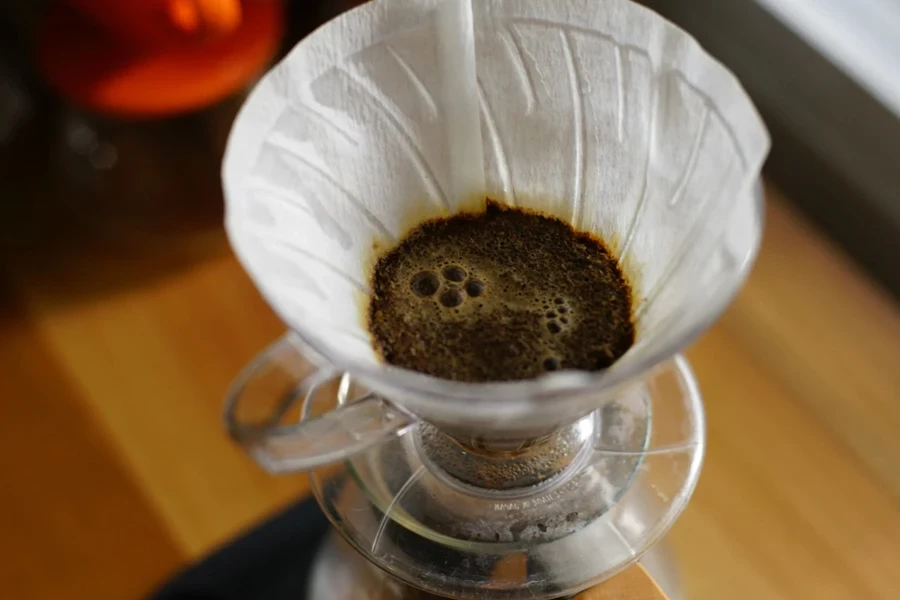It’s easy to think that these timeless icons are irrelevant with the advent of espresso machines and the latest coffee makers. But, in reality, percolators are still making the rounds. One of the main reasons is that they allow consistent water cycling, which offers in-depth flavor extraction during the brewing process.
The versatility of the percolators is another distinct feature that helps users customize their coffee to their preferred taste. Another highlight of the percolators is how they focus on temperature detail, which affects the coffee quality. Read on to learn what’s key in the world of coffee percolators.
Table of Contents
Coffee percolators: what are they?
Types of coffee percolators
Top aspects to prioritize when picking coffee percolators
Wrapping up
Coffee percolators: what are they?

Although many modern and exciting ways to brew coffee have graced the market, many people simply prefer the old-school style, and percolators fall under the category of traditional brewing methods that are gaining traction. These coffee pots are famous for their continuous cycling process and gravity reliance that runs near-boiling through coffee until consumers get their desired strength.
Nevertheless, what makes these coffee percolators stand out the most is their intense brew strength. These pots make stronger coffee, sometimes even too strong if the brew cycle runs too long. Percolators are also handy for making large coffee batches for groups.
Types of coffee percolators
Electric coffee percolators
The biggest advantage of electric percolators is their simplicity. Consumers just fill the water chamber, add coffee grounds, and let the device handle the rest—there is no need for an external heat source or close monitoring. Most electric percolators have automatic keep-warm functions that switch to a mode that keeps the coffee warm for serving once it reaches the desired brewing strength.
Additionally, electric percolators are relatively self-contained. As long as consumers have access to electrical outlets, they can work effectively. For this reason, electric percolators are suitable for offices, dorm rooms, or events. Lastly, they often come in sizes suitable for making several cups of coffee at a time!
Stovetop coffee percolators

Electric models may be simple, but stovetop coffee percolators have simpler designs. Despite their simplicity, they aren’t less durable, as manufacturers make them from sturdy materials like stainless steel—these pots are long-lasting and hard to break. What’s even cooler is that stovetop percolators are the classic camping coffee solution.
All consumers need is a heat source (like a campfire or portable stove), and they can brew coffee anywhere. Stovetop coffee percolators offer more control over brew strength since consumers can monitor the process visually (often through a glass dome on the lid) and remove the pot from the heat when it’s ready.

Some stovetop percolators also work with simple metal baskets, eliminating the need for paper filters. Since they don’t need electricity, they are perfect for off-grid situations, power outages, or those looking to rescue unnecessary energy consumption. Plus, they have a more old-fashioned charm than electric variants.
Microwave percolators
While microwave percolators are a thing, they are more of a niche product and come with many trade-offs. They may not be as great as electric or stovetop models, but they have their uses. For instance, microwave percolators can brew coffee faster than stovetop versions, though not as quickly as some electric models.
Microwave percolators are also dedicated to smaller volumes, making them perfect for consumers who primarily make single servings. Their smaller sizes make them ideal for smaller kitchens with limited counter space and storage. Conversely, microwave percolators usually feature plastic or heat-resistant glass, making them less durable than other models; they may also slightly affect coffee flavor.
Microwave heating isn’t always consistent, potentially leading to uneven coffee ground extraction. Consumers also have little to no control over brew time or temperature, making it hard to fine-tune their coffee. Despite these downsides, microwave percolators are decent for making quick, single cups of coffee and fulfilling the need for a very affordable brewing method.
Glass coffee percolators
The biggest advantage of glass percolators is that consumers can see the entire brewing process. As a result, they can monitor the brew’s strength visually and help prevent over-extraction. Since glass is a neutral material, it will not add any off-flavors to the brew, ensuring the purest coffee experience.
Glass percolators have a timeless, charming aesthetic that appeals to many people. In fact, they are a great way to add a touch of vintage style to any kitchen. While glass may seem fragile, the high-quality borosilicate glass used in most percolators is surprisingly durable and heat-resistant—though still prone to breakage with improper handling.
Top aspects to prioritize when picking coffee percolators
Capacity

The primary reason for considering capacity when choosing coffee percolators is to match the consumer’s intended batch size. Generally, percolators are excellent for larger batches, but smaller capacities may not be ideal if consumers are brewing for several people. Capacity also determines the percolator’s brew strength.
Percolators that are too large for the amount of coffee consumers want to make may result in over-extraction and a bitter brew due to the water circulating too often. Here’s a table showing the different coffee percolator capacities to look for. But before that, sellers must note that manufacturers frequently use “cup” to measure capacity—coffee “cups” are usually around 5–6 ounces, smaller than a standard 8-ounce cup.
| Capacity (cups) | Approximate yield (standard 80z cups) | Best suited for |
| 4–5 cups | 2–3 standard cups | An individual or a couple |
| 8–9 cups | 4–5 standard cups | Small groups and families |
| 12+ cups | 6+ standard cups | Larger gatherings and events |
Accessories
Percolators offer a great brewing experience, but it gets better when consumers have the right accessories. Some manufacturers add these accessories to their percolators, but businesses can throw in some extras to make them a more valuable set. Take a closer look at the different useful and essential accessories.
Replacement basket
Percolator baskets are a necessary part of the system—after all, they are where consumers place their coffee grounds for brewing. Hence, most consumers may prefer having a spare on hand in case the original gets damaged or needs cleaning while they are brewing another batch.
Replacement gaskets (if applicable)
Some percolators have rubber gaskets that create a seal when brewing. However, these wear out over time, so having replacements ensures these coffee pots maintain a tight seal—no aromas will escape with these bad boys on hand.
Filters

While percolators often work without filters, they are still great additions to the coffee-brewing experience. A fine-mesh, paper, or reusable cloth filter can help reduce sediment in coffee and create smoother cups.
Coffee grinder

Since percolators work best with medium-coarse grinds, consumers need this accessory to adjust their grind size for optimal flavor. Also, pre-ground coffee may be too fine to maximize the benefits of percolators.
Design
Percolators come in different designs and shapes, making some pieces visually striking. Cylindrical is the most traditional percolator form, resembling a tall cylinder and offering a sleek, timeless appearance. Tapered shapes are also great! They feature wider bases that taper toward the top, making them more stable and visually appealing.
A less common but visually striking shape is the hourglass. Percolators with this shape have a thinner section in the middle and wider base and top sections. Although percolators are a shout-out to the past, some modern design elements have also made them more appealing. Some percolators have sharp angles and geometric elements, making them feel contemporary.
Material
Percolators can feature different materials to give them various effects. For example, stainless steel percolators are quite popular for their extreme durability and resistance to dents, scratches, and breakage. They also have that classic and timeless appearance that’s appealing to many consumers. And since they are dishwasher-safe, stainless steel percolators are generally easy to clean.
On the other hand, glass provides complete visibility, making it perfect for judging brew strength by color. They can also add a vintage charm to any kitchen. However, they lack the stovetop compatibility of stainless steel models (these can work on any heat source).
Glass and stainless steel are expensive, so some manufacturers reduce the cost by using aluminum. In addition to being lightweight and affordable, aluminum percolators can conduct heat quickly, leading to faster coffee brewing times. However, they can react with coffee and potentially add a metallic taste. Experts also don’t recommend them for frequent use.
Similarly, plastic offers an affordable way to enjoy coffee brewing. However, sellers can only find the material on microwave percolators. They may also add an unwanted flavor to coffee and are significantly less durable than other materials.
Wrapping up
Percolators may be an older way to brew coffee, but they are nowhere near falling out of favor. Check out these stats: coffee percolators are getting 135,000 searches monthly in 2024, showing they are still in high demand! Businesses can capitalize on this nostalgic trend by stocking up on the amazing coffee percolators that consumers want.
This article will help sellers know what to look for when choosing these amazing coffee devices in 2024. Stay up-to-date with the latest home and garden topics by subscribing here.




